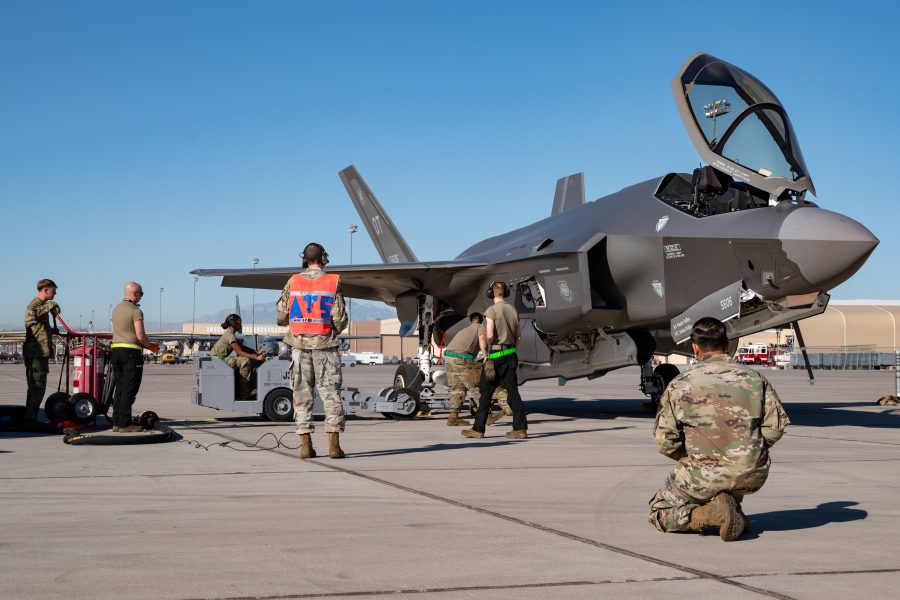With the Air Force in the midst of its biggest testing boom in decades, a division at Nellis Air Force Base, Nev., is making sure those tests include an often-overlooked perspective: that of maintainers.
“We do a really good job at evaluating software and hardware components to make sure it works for the air crew, but no one was giving the same kind of look to maintenance for a long time,” said Capt. Cameron Castleberry, head of the Maintenance Operational Test (MxOT) Division within the 59th Test and Evaluation Squadron.
Formed two years ago, MxOT focuses on fighter maintenance, teaming maintenance experts alongside test pilots, engineers, and acquisition specialists.
“We can answer the question of, is it effective for ops, but also, is it suitable and sustainable for the long term for maintenance and the logistics footprint?” Castleberry told Air & Space Forces Magazine earlier this month.
Maintenance has its own tactics, techniques, and procedures for sustaining aircraft and identifying potential challenges with both physical components and digital software. Because MxOT’s team members have operational experience, they can provide unvarnished, practical feedback to testing teams.
That feedback can include bult assessments, such as “’This isn’t going to make sense for our maintainers out in the [Combat Air Force],’ and ‘it’s certainly not going to improve the CAF and the maintainers who are actually out in a contested environment,’” said 2nd Lt. Taleah Cooper, MxOT’s Assistant Project Manager.
The benefits are obvious. “The longer it takes maintainers to work on something on the ground because something is not suitable for them, the less we’re actually putting jets in the sky,” Cooper said. “So anything that we can help make sure that maintainers are able to fix things the way that they should and do their jobs even better is our goal with every single test and tactic that we develop.”
Major upgrades for the F-35 and F-22 highlight how critical it is to get maintainers’ perspectives. Any changes to the fifth-generation jets can require major adaptations down the line.
“When you mess with software, some things change other parts that you didn’t intend to, right?” said Castleberry. “So we provide an on-the-ground, real-time look at what some of those changes do.”
The F-22’s Raptor Agile Capability Release program is delivering rapid upgrades at an increased pace, including both software and hardware. In addition to quarterly test events devoted to reliability, maintainability, and sustainability, Tech Sgt. Victoria Hall, F-22 Operational Test & Evaluation Production Superintendent, said MxOT also holds “mini-events” to enable the team to quickly document and sign off on a fix, rather than holding it back from release for weeks or months.
At the same time, MxOT is testing new procedures to help ensure Airmen can regenerate aircraft when operating under stress in an agile combat employment operation, with limited resources and little time to spare
Castleberry cited two ongoing updates for the F-35, one to develop a checklist of procedures so pilots can check their aircraft independently before taking off again and the other to do integrated combat turns. Both would contribute to ACE scenarios and testing is ongoing for both, with safety mechanisms in place.
“When you think about maintenance as a whole and the test community as a whole, culturally, the two couldn’t be further apart,” Castleberry said. “That’s for very good reason: Maintenance is in charge of generating airpower that is safe and effective for pilots, and so by virtue of that, they have a lot of rules. They have a lot of guidance and a lot of guidelines to keep the aircraft safe and airworthy. … Whereas the test community, as a whole, is very much on the other side of that spectrum, where they want to be leading it, they want to be to the tip of the spear, and they need to, for the warfighter, to go try risky things and do things that are potentially non-standard to generate the right stuff for the warfighter.
“So those two things are very different, just culturally, and that is OK. It is very interesting and fun, from my perspective, to watch those two things merge, because there’s a balance right between needs and wants for both sides.”
